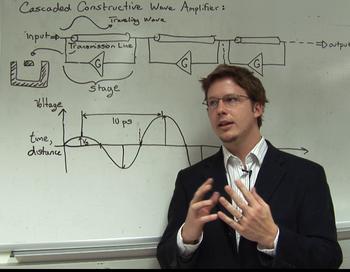NSF Awards $1.2 Million to UCSD/UCLA to Pinpoint Unused Space in Wireless Spectrum
By Tiffany Fox, (858) 246-0353, tfox@ucsd.edu
Oct. 24, 2013, San Diego, Calif. — A research collaboration between the University of California campuses in San Diego and Los Angeles has been awarded $1.2 million from the National Science Foundation to enable smartphones, sensors and other software-defined radio devices to rapidly and precisely pinpoint bands of unused radio spectrum and eliminate any existing signal interference.
The team’s hardware-based approach will “open up the radio spectrum and make high-speed communication more accessible to more people in our society,” explained Prof. James Buckwalter of the UC San Diego Electrical and Computer Engineering (ECE) Department.
|
The four-year project, which will be funded by the NSF Enhancing Access to the Radio Spectrum (EARS) program, is a collaboration with Buckwalter’s co-principal investigator, ECE Prof. Ian Galton of UC San Diego, as well as Danijela Cabric and Dejan Markovic of UC Los Angeles. Buckwalter is affliliated with the Qualcomm Institute at UC San Diego and oversees lab space there.
“This project is a way to bridge discoveries and build radio frequency spectrum access for a future when wireless networks will be extremely congested,” said Buckwalter. “The idea is to democratize the radio spectrum so that people have more unlicensed bands at their fingertips.”
According to Federal Communications Commission regulations, consumers in the United States can access a limited number of unlicensed frequency bands, such as WiFi and Bluetooth, at no cost, whereas cellular providers must pay for licensed bands from the FCC. Consequently, unlicensed bands tend to be extremely congested as the number of wireless devices grows exponentially, which results in signal interference, data transmission bottlenecks and lost calls. Meanwhile, licensed bands are relatively reliable, but consumers pay the price by way of their monthly cell phone bills.
Although the nationwide move in 2009 from analog to digital television freed up some of the available broadcast frequency spectrum, engineers have continued to look for ways to make more efficient of the unlicensed spectrum. The UCSD/UCLA team is hoping that their three-pronged ‘spectrum sensing’ approach -- which combines algorithms, signal processing and integrated circuits -- will optimize the unused ‘white spaces’ located between 200-700 megahertz on the frequency spectrum.
“The idea is that if there was more unlicensed spectrum, we might be smarter about how we use it,” added Buckwalter. “We want to be able to zoom in on a very narrow spot on the spectrum and see if it is being used. Detecting ‘vacancies’ and informing users in real-time about where to transmit and where to receive a signal could greatly expand capacity.”
One of the inherent challenges with this approach, noted Buckwalter, is that the cognitive radios of the future -- intelligent radios that can be configured and programmed on the fly -- will operate over multiple frequency bands spread out over a wide frequency range. That’s something the ‘notch filters’ in mobile devices, for example (which only allow in certain frequencies to prevent signal distortion) are not designed to accommodate.
Moreover, to find the usable ‘white spaces,’ radios must also be able to agilely hop between frequency bands, but the time required by the radio to detect the power within any channel compromises this ability.
The solution Buckwalter and his colleagues have designed will leverage hardware that “can reconfigure the notch filters to optimally minimize distortion that falls into the band we’re interested in,” he explains. To do so, they have proposed signal processing concepts to detect changes to the spectral environment and allow coarse and fine tuning of filters that mitigate interference. These concepts will also be used to determine sources of distortion and cancel them out -- making more spectrum available to more users, for (hopefully) less monetary cost.
Media Contacts
Tiffany Fox, (858) 246-0353, tfox@ucsd.edu
Related Links


